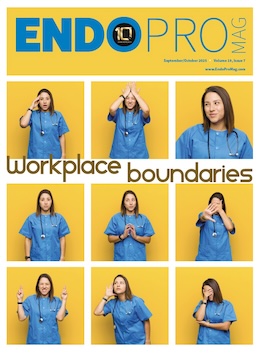More and more people in today’s fast-paced working environment feel perpetually on edge: unable to focus, plagued by a nonstop stream of notifications, and exhausted before the day even ends. This is due in part to overstimulation, which, in the healthcare setting, can be worse than almost anywhere else.
Overstimulation is when the brain becomes overwhelmed by too much sensory, cognitive and emotional input—in other words, far more than it can efficiently process. Overstimulation may result in irritability, exhaustion, lowered productivity and, finally, burnout. The modern workplace, with its open-concept offices, constant digital communications, and the demand for employees to be “always on,” has become a prime contributor to this growing problem.
Overstimulation is different from stress. Overstimulation is the state one goes through after being put through excessive use of information or sensory input in a short period of time. This could include noise, bright light, constant meetings, or multitasking in the hyper-connected world. When overstimulated, the brain can’t filter distractions and is unable to focus on the processing of emotions or any meaningful work.
Overstimulation occurs when incoming information, intearctions and sensory experience combined outpaces the brain’s capacity to process. A 2023 study in The Journal of Neuroscience reported that sensory overload complaints had increased 40% from pre-pandemic levels; this may well be a shift exacerbated by a return to office spaces and a surge in digital communication.
The Modern Work Environment
We work a lot differently now than we did just 15 years ago, and many of the innovations in the modern workplace—well-intentioned to help people collaborate and work more efficiently—surely serve to increase overstimulation. Here’s how:
The Open-Office Dilemma
Open-concept offices were once lauded as the future of collaboration. In reality, they’re often a sensory minefield of conversation, ringing phones, clacking keyboards, and impromptu meetings—making it nearly impossible for workers to focus. In that way, they’re not all that different than your typical nurse’s station or surgery center office. Researchers at Harvard Business Review found that, due to noise and distraction, employees in open offices experience a staggering 15% loss in productivity.
The average worker gets 121 emails a day and countless messages, texts and notifications. And with the expectation of immediate response, employees are constantly switching between tasks, leading to cognitive fatigue. According to a study by the University of California at Irvine, it takes an average of 23 minutes to refocus after an interruption, making digital overload one of the biggest contributors to overstimulation in the workplace.
Back-to-Back Meetings and Multitasking
Most employees find themselves caught in a vicious circle of back-to-back meetings, leaving little or no time for deep work. The compulsion to multitask—doing emails while on calls or messaging during meetings—prevents full engagement and increases cognitive strain.
The “Always-On” Culture
With the introduction of remote and hybrid work, the line between personal and professional life has continued to blur; people may feel obligated to check emails after hours or respond to late-night messages, leaving little time for actual mental recovery.
What Employers Can Do to Reduce Overstimulation
Creating a healthier work environment isn’t just about reducing stress; it’s about rethinking how we structure work to minimize cognitive overload. Employers can make a difference by instituting changes that protect mental well-being while sustaining productivity.
1. Normalize Quiet Spaces and Flexible Work Zones
While collaboration is invaluable, employees also need spaces where they can work without interruptions. Quiet rooms, soundproof pods, and “focus hours” can help temper the sensory overload of open offices.
2. Rethink Communication Overload
Organizations should set norms around communication to limit unnecessary digital interruptions. Encouraging scheduled check-ins rather than constant instant messaging, and implementing email-free focus periods, can make a big difference.
3. Prioritize Meaningful Breaks
Brief, intentional breaks throughout the day—say, walking outside, meditating or simply looking away from screens— reset the brain and prevent overstimulation from building up.
4. Create Meeting-Free Time Blocks
Companies like Shopify and Asana have successfully introduced “meeting-free days,” allowing employees uninterrupted time for deep work. Limiting meetings to specific time blocks can give employees more control over their schedules.
5. Encourage Separation of Work and Personal Life
Employers should model healthy boundaries by not intruding on employees’ time outside of work. Simple things, such as discouraging after-hours emails and setting clear expectations around availability, can prevent the always-on mentality that contributes to overstimulation.
What Employees Can Do to Protect Themselves
While organizational change is crucial, employees can also take proactive steps to manage overstimulation in their daily routines. These tips include:
Identify your triggers. Notice where and when overstimulation usually occurs, such as a noisy office, constant email pings, or back-to-back meetings.
Set boundaries with your digital tools. Turn off nonessential notifications, batch and check emails, and set “do not disturb” on during your focus time.
Take a sensory break. This may be breathing exercises, time away from screens, or sometimes just closing one’s eyes for a few moments—anything to help the nervous system reboot.
Express need. People are different. If some of the factors that are overstimulating you can be improved, talk with your manager or anyone else who may be able to help.
The Future of Work Deserves Smarter Spaces
Overstimulation is a challenge that calls for meaningful steps toward healthier, more sustainable work environments. It means rethinking building layouts, digital communication habits, and workload expectations to create a space where employees don’t just survive the workday but thrive in it. Taking proactive steps to reduce overstimulation isn’t just about productivity; it’s about creating a culture where employees can bring their best selves to work without the constant burden of mental overload.
Healthcare practitioners have no shortage of stress, and the job has some degree of overstimulation built in. However, reasonable steps can be taken to reduce overstimulation, and the changes will benefit both practitioners and the patients they care for.








